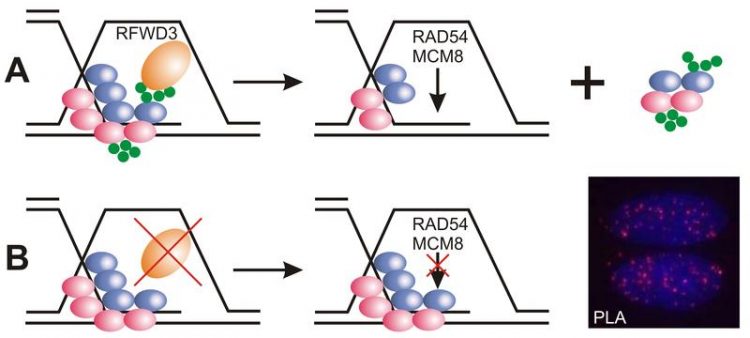New gene mutation associated with Fanconi anemia

A: The enzyme RFWD3 helps target other proteins on single-stranded DNA for degradation. B: Cells lacking RFWD3 show DNA repair defects. (Figure modified from Inano et al.)
Fanconi anemia is a rare genetic disease characterized by bone marrow failure heralded by low platelet counts and unusually large red blood cells. Mutations in over 20 genes have been identified as causative for Fanconi anemia, which encode proteins commonly involved in DNA repair mechanisms.
The failure to repair DNA is considered the source of increased cancer risk in individuals with Fanconi anemia. Ongoing efforts to identify additional genes and pathways linked to this disease may concurrently reveal potential susceptibility genes for hereditary cancers.
This week in the Journal of Clinical Investigation (JCI), a team led by Detlev Schindler at the Julius-Maximilians-Universität (JMU) Würzburg in Bavaria, Germany, reports classical Fanconi anemia symptoms in a 12-year-old individual without mutations in any of the known Fanconi anemia genes.
Mutations detected
Sequencing of this individual’s genome detected mutations in both alleles of the gene RFWD3, which encodes an enzyme that helps target other proteins on single-stranded DNA for degradation. This process is impaired in patient’s cells which rendered them more sensitive to chromosome breakage and DNA damage, compared to cells from healthy individuals.
Other cells either lacking RFWD3 or genetically engineered with the patient’s missense mutation showed similar DNA repair defects, which were rescued by expression of wild-type RFWD3. Moreover, RFWD3-deficient mice exhibited a phenotype that resembles other mouse models of Fanconi anemia. Together, these findings support the identification of RFWD3 as a Fanconi anemia gene.
„Biallelic mutations in the ubiquitin ligase RFWD3 cause Fanconi anemia“, Kerstin Knies, Shojiro Inano, María J. Ramírez, Masamichi Ishiai, Jordi Surrallés, Minoru Takata, and Detlev Schindler. Journal of Clinical Investigation, 10. July 2017, DOI: 10.1172/JCI92069
Schindler and collaborators further describe the mechanisms by which RFWD3 mediates DNA repair in two accompanying studies recently published in Molecular Cell. Future explorations of this enzyme may reveal its importance as a therapeutic target in certain subtypes of Fanconi anemia or cancer.
Contact
Prof. Dr. Detlev Schindler, Institute of Human Genetics, University of Würzburg, Germany, T +49 931 31-88075, schindler@biozentrum.uni-wuerzburg.de
http://www.jci.org/articles/view/92069 Publication in the Journal of Clinical Investigation
https://doi.org/10.1016/j.molcel.2017.04.022 Publication 1 in „Molecular Cell“
http://dx.doi.org/10.1016/j.molcel.2017.04.021 Publication 2 in „Molecular Cell“
Media Contact
All latest news from the category: Life Sciences and Chemistry
Articles and reports from the Life Sciences and chemistry area deal with applied and basic research into modern biology, chemistry and human medicine.
Valuable information can be found on a range of life sciences fields including bacteriology, biochemistry, bionics, bioinformatics, biophysics, biotechnology, genetics, geobotany, human biology, marine biology, microbiology, molecular biology, cellular biology, zoology, bioinorganic chemistry, microchemistry and environmental chemistry.
Newest articles

First-of-its-kind study uses remote sensing to monitor plastic debris in rivers and lakes
Remote sensing creates a cost-effective solution to monitoring plastic pollution. A first-of-its-kind study from researchers at the University of Minnesota Twin Cities shows how remote sensing can help monitor and…

Laser-based artificial neuron mimics nerve cell functions at lightning speed
With a processing speed a billion times faster than nature, chip-based laser neuron could help advance AI tasks such as pattern recognition and sequence prediction. Researchers have developed a laser-based…

Optimising the processing of plastic waste
Just one look in the yellow bin reveals a colourful jumble of different types of plastic. However, the purer and more uniform plastic waste is, the easier it is to…



